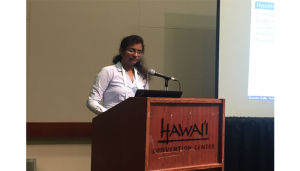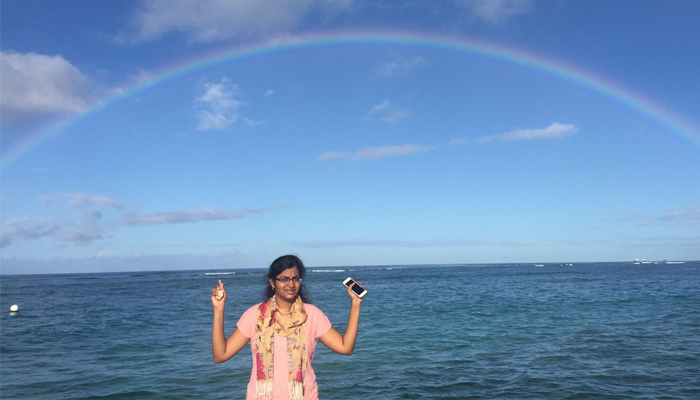Having spent the majority of her primary education in Tirupati and later in Vijayawada, final year CS student Sireesha Naidu Galla comments wryly that much like everyone else, she too had to “endure a rat race to come here”. “When I first joined IIIT-H and chose CS as a dual degree student, I had no clue about research”, she says quite candidly. However, she hastens to add that the exposure to different domains of research at IIIT-H provides a broad perspective and helps students narrow down their specific areas of interest.
Real World, Real Problems
“I always wanted to build and develop something closer to the real world”, she says. And that’s how she found herself in the Lab of Spatial Informatics (LSI). Work in this research centre focuses on solving different problems such as global environmental change, spatial data compression and visualisation, analysis and remote sensing using the strengths and progress in Information technology. “The research here is creating a huge impact on people and the society”, according to Sireesha.
Thesis: Estimating Droughts and Water Availability
Sireesha speaks fondly of her mentor and guide Dr. Rehana saying the professor has always been supportive. “She has never doubted our abilities to do things in different research areas, she helped us in finding problem statements in areas we were passionate about.” Sireesha is currently in the process of wrapping up her thesis work on Estimation of drought over Krishna River Basin in India Using Potential and Actual Evapotranspiration and prediction of drought and water availability in the future with rainfall and temperature estimated using Statistical Downscaling and hydrological Modelling. She explains it by saying that drought is said to occur when there is unavailability of regular residual water balance. This residual water balance is estimated considering the difference between precipitation and Evapotranspiration. Evapotranspiration is the sum of evaporation from the ground and transpiration or the water evaporating from plants and trees. Since these differences typically vary in terms of quantity in different regions, Sireesha says that it is inaccurate to take an absolute measure to estimate drought in all the regions. Hence drought indices can be considered as more reliable predictors of drought. To estimate drought based on a drought index, a statistical distribution is fitted to these differences (residual water balance values) and then irregularities are classified as drought/wet conditions. This model is validated for the current time period and applied for the future climate variables to estimate the drought severity, frequency and water availability in a spatial context.
Paper Presentations
In June, Sireesha presented two papers on ‘A Comparative Analysis of Regional Drought Characterization over Krishna River Basin in India Using Potential and Actual Evapotranspiration’ and the other on ‘Candidate Distributions for Drought Characterization Using Standardized Precipitation Evapotranspiration Index for Meteorological Zones of India ‘ co-authored by N.T. Monish and Dr Shaik Rehana at the 15th annual conference of Asia Oceania Geosciences Society (AOGS) held in Honolulu, Hawaii. The prime focus of the AOGS is on Asia and Oceania because as per their official website, this region is particularly vulnerable to natural hazards, accounting for almost 80% human lives lost globally. “Understanding drought categorization, water availability and prediction of drought will help in the management of water resources for the present and future generations,” affirms Sireesha.

Funding
Sireesha’s research work has been funded by the Science and Engineering Research Board (SERB), and the Department of Science and Technology (DST), Government of India. In addition to this, Sireesha received travel grant from the research centre, LSI to attend the conference.

Other Interests
Attributing her success to the support she received from family and friends, Sireesha says, “I am glad that my father accompanied me for this conference and planned the trip in an educational way.“ A self-confessed history buff, she managed to mix work and her interest in History with a visit to the USS Arizona Memorial at Pearl Harbor. An interesting natural phenomenon that she encountered during her trip was the vegetation at the Muir Woods National Park. “It’s a forest growing as a narrow strip with trees ranging from 300 to 400 ft in a region which generally has trees not more than 20 feet tall!”, she exclaims. Not particularly an outdoorsy person, she speaks wistfully of developing a habit of playing sports regularly and doing outdoor activities. Sireesha has just begun her corporate career at Oracle in the talent management team for Human Capital Management. But that doesn’t stop her from dreaming about creating opportunities for everyone to have access to and gain knowledge: “I want to develop mini-libraries, digital and brick-and-mortar, in various places to create conducive environments for young minds.”



Next post